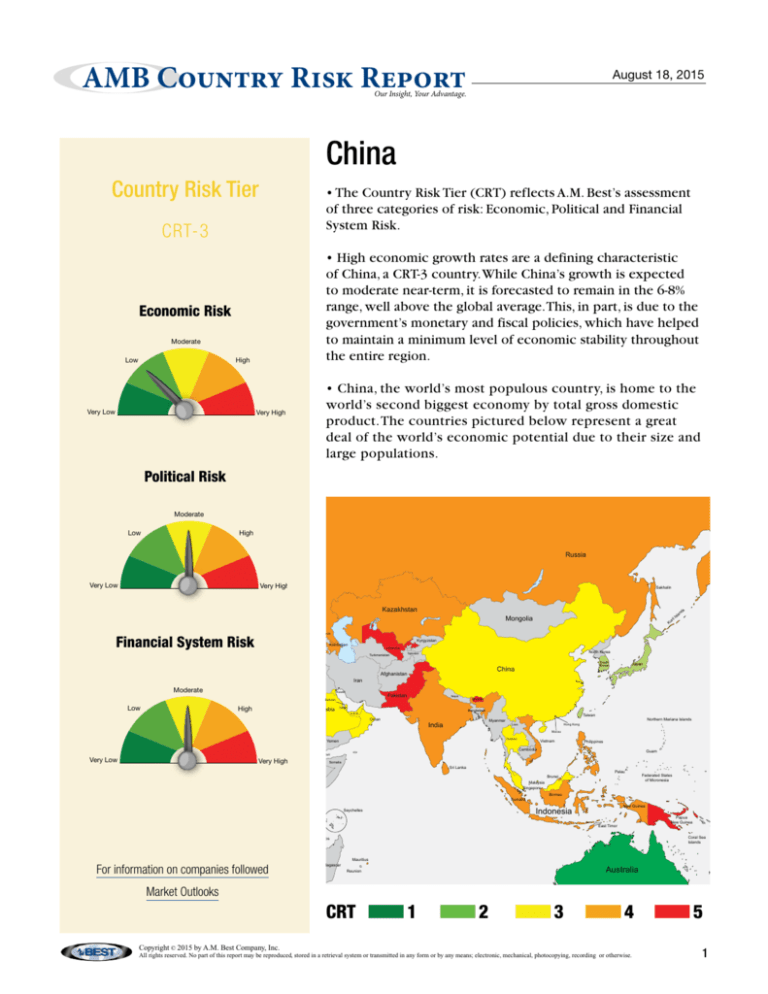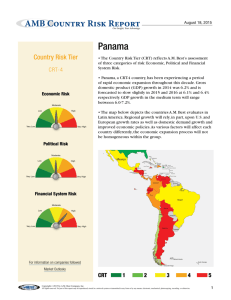
h
a
AMB Country Risk Report
August 18, 2015
Our Insight, Your Advantage.
China
Country Risk Tier
• The Country Risk Tier (CRT) reflects A.M. Best’s assessment
of three categories of risk: Economic, Political and Financial
System Risk.
CRT-3
• High economic growth rates are a defining characteristic
of China, a CRT-3 country. While China’s growth is expected
to moderate near-term, it is forecasted to remain in the 6-8%
range, well above the global average. This, in part, is due to the
government’s monetary and fiscal policies, which have helped
to maintain a minimum level of economic stability throughout
the entire region.
Economic Risk
Moderate
Low
High
Very Low
• China, the world’s most populous country, is home to the
world’s second biggest economy by total gross domestic
product. The countries pictured below represent a great
deal of the world’s economic potential due to their size and
large populations.
Very High
Political Risk
Iceland
Finland
Moderate
Greenland
Low
Sweden
High
Norway
Estonia
Isle of Man
Ireland
Very Low
Lithuania
Belarus
United
Kingdom
Netherlands
Guernsey
Liechtenstein
Czech
Republic
Austria
Switzerland
France
Kazakhstan
Republic of
Moldova
Hungary
Slovenia
Bosnia & Serbia
Herzegovina
Andorra
Bulgaria
Montenegro
Georgia
Macedonia
Armenia
Albania
Spain
Portugal
Gibraltar
Tunisia
Malta
Cyprus
Syria
Low
Saudi Arabia
Nepal
Qatar
Bhutan
Bangladesh
U.A.E.
Oman
Myanmar
India
Taiwan
Northern Mariana Islands
Hong Kong
Laos
Wake Island
Macau
Mali
Chad
Niger
Senegal
Eritrea
Sudan
Gambia
Thailand
Yemen
Vietnam
Philippines
Cambodia
Benin
Very High
Nigeria
Somalia
Sri Lanka
Central Africa Republic
Togo
Equatorial Guinea
Sao Tome & Principe
Ethiopia
Brunei
Gabon
Congo
Palau
Malaysia
Singapore
Cameroon
Uganda
Kenya
Sumatra
Rwanda
Dem. Republic
Burundi
of Congo
Seychelles
Tanzania
azil
Malawi
Nauru
New Guinea
Indonesia
Namibia
Market Outlooks
Mauritius
Madagascar
Botswana
Solomon Islands
Reunion
Australia
New Caledonia
Swaziland
Norfolk Island
Lesotho
South Africa
Tuvalu
Vanuatu
Mozambique
For information on companies followed
Papua
New Guinea
Coral Sea
Islands
Comoros
Zambia
Zimbabwe
Federated States
of Micronesia
Borneo
East Timor
Angola
Marshall Islan
Guam
Dijbouti
Burkina Faso
Ghana
Guinea
Sierra
Cote d'Ivoire
Leone
Liberia
Pakistan
Bahrain
Egypt
High
Western Sahara
Guinea-Bissau
Japan
Iran
Kuwait
Libya
(Occupied by Morocco)
Very Low
South
Korea
China
Jordan
Moderate
Algeria
Cape Verde
North Korea
Tajikistan
Afghanistan
Iraq
Israel
Morocco
Mauritania
Uzbekistan
Turkmenistan
Lebanon
Canary
Islands
s
nd
la
Is
Kyrgyzstan
Azerbaijan
Turkey
Greece
Monaco
ril
Ku
Russia
Financial System Risk
Italy
Mongolia
Romania
Croatia
San Marino
Sakhalin
Ukraine
Slovakia
Luxembourg
Jersey
Very High
Poland
Germany
Belgium
Azores
Russia
Russia
Latvia
Denmark
CRT 1 2 3 4 5
Copyright © 2015 by A.M. Best Company, Inc.
All rights reserved. No part of this report may be reproduced, stored in a retrieval system or transmitted in any form or by any means; electronic, mechanical, photocopying, recording or otherwise.
1
New Zealand
F
AMB Country Risk Report
China
Regional Summary: Eastern Asia
Vital Statistics 2014
• Eastern Asia is home to some of the world’s
largest and most advanced economies.
China (#2 in the world), Japan (#3) and
South Korea (#13) dominate much of the
regional economy as measured by gross
domestic product (GDP) by the International
Monetary Fund at year end 2014.
• Potential GDP growth is likely to
slow reflecting weaker productivity
gains, infrastructure bottlenecks in
some countries and the effects of aging
populations across the region.
• Vulnerabilities associated with high debt
levels are increasing in the region as past
credit booms helped to finance consumption,
government spending and investment.
Nominal GDP
Population
GDP Per Capita
Real GDP Growth
Inflation Rate
Premiums Written (Life)
Premiums Written (Non-Life)
Premiums Growth (2013 - 2014)
Country Risk Tier
CRT-3
CRT-2
CRT-2
CRT-2
CRT-2
CRT-2
China
Hong Kong
Japan
Macau
South Korea
Taiwan
Source: IMF, Axco, Swiss Re and A.M. Best
Economic Growth
• China, with a population of 1.37 trillion
people, is home to the world’s second
largest economy after the U.S. Economic
growth in China is driven by a strong export
sector, state expenditures, construction and
infrastructure development.
• Total debt levels (including government,
household and corporate) have climbed
to over 200% of GDP, up approximately
100 percentage points since 2008.The
debt allowed China to stimulate growth
through the global financial crisis, but
once deleveraging commences, future
economic growth may be hindered.
10380.38
1367.8
7,589
7.4
2.0
176,950
151,490
17.2
Regional Comparison
Economic Risk: Low
• The IMF is projecting that China will
have growth rates of 6.8% and 6.3% for
2015 and 2016, respectively.The slowdown
in economic growth is attributed to
demographic trends, over investment,
structural reforms and high debt levels.
USD bn
mil
USD
%
%
USD mil
USD mil
%
16
Real GDP
CPI Inflation
14
12
10
%
8
6
4
2
0
2006
2007
2008
2009
2010
2011
2012
2013
2014
2015
2016
2017
2018
2019
2020
-2
Source: IMF World Economic Outlook and A.M. Best
• China ranks 90th out of 189 countries
in the World Bank’s 2015 Ease of Doing
Business survey.
2
AMB Country Risk Report
China
Political Risk: Moderate
Political Risk Summary
• Power in China is centralized in the
Communist Party of China. Current
President Xi Jinping has been in power
since 2012 and has included tackling
corruption as one of the government’s
main priorities. Hundreds of officials
have been censured with some high
level officials removed from office and
placed on trial.
Score 1 (best) to 5 (worst)
China
World Average
International Transactions
Policy
5
4
Legal System
Monetary Policy
3
2
1
Regional Stability
Fiscal Policy
• Beijing seeks to balance its
communist central government with
capitalist-style economics that exist in
the industrial centers.
0
Social Stability
Business Environment
Government Stability
• The government has pursued a gradual
approach to market liberalization.The
state still has a significant presence in the
industrial sector and a dominant presence
in the banking and energy sectors.
Labor Flexibility
Source: A.M. Best
• The country has experienced some
social and ethnic tensions stemming
from a large and diverse population and
growing income inequality.
GDP Per Capita and Population
for Selected Countries
Financial System Risk: Moderate
120,000
1600
GDP Per Capita
Population
1400
100,000
1200
80,000
• The Chinese Insurance Regulatory
Commission (CIRC) regulates the
insurance industry. The Insurance Law
was amended in 2009 to enhance
regulation in core areas, such as the
strength of the supervisory authority and
solvency and investment guidelines.
USD
Millions
1000
60,000
800
600
40,000
400
• All large financial institutions
are state-owned. China is partially
liberalizing its financial sector, which
is a long and drawn-out process, but
essential for the long-term sustainability
of the economy.
20,000
200
0
China
Hong Kong
Source: IMF and A.M. Best
Japan
Macau
South Korea
Taiwan
0
• In late 2014, the Asian Infrastructure
Investment Bank was launched by
the Chinese government to provide
financing to infrastructure projects in
the region.
3
AMB Country Risk Report
China
GUIDE TO BEST’S COUnTry rISk TIErS
A.M. Best defines country risk as the risk that country-specific factors could adversely affect the claims-paying ability of an insurer. Country risk is
evaluated and factored into all Best’s Credit Ratings. Countries are placed into one of five tiers, ranging from “CRT-1” (Country Risk Tier 1), denoting
a stable environment with the least amount of risk, to “CRT-5” (Country Risk Tier 5) for countries that pose the most risk and, therefore, the greatest
challenge to an insurer’s financial stability, strength and performance.
A.M. Best’s Country Risk Tiers are not credit ratings and are not directly comparable to a sovereign debt rating, which evaluates the ability and
willingness of a government to service its debt obligations.
Country risk Tiers
Country risk Tier
Definition
CRT-1
Predictable and transparent legal environment, legal system and business infrastructure; sophisticated financial
system regulation with deep capital markets; mature insurance industry framework.
CRT-2
Predictable and transparent legal environment, legal system and business infrastructure; sufficient financial system
regulation; mature insurance industry framework.
CRT-3
Developing legal environment, legal system and business environment with developing capital markets; developing
insurance regulatory structure.
CRT-4
Relatively unpredictable and nontransparent political, legal and business environment with underdeveloped capital
markets; partially to fully inadequate regulatory structure.
CRT-5
Unpredictable and opaque political, legal and business environment with limited or nonexistent capital markets; low
human development and social instability; nascent insurance industry.
Country risk reports
A.M. Best Country Risk Reports are designed to provide a brief, high-level explanation of some of the key factors that determine a country’s Country
Risk Tier assignment. It is not intended to summarize A.M. Best’s opinion on any particular insurance market or the prospects for that market.
Categories of risk
Country Risk Reports provide scores for three categories of risk for each country. These scores are (1) Very Low; (2) Low; (3) Moderate; (4) High
and (5) Very High.
Category of risk
Definition
Economic Risk
The likelihood that fundamental weaknesses in a country’s economy will cause adverse developments for an insurer.
A.M. Best’s assessment of economic risk evaluates the state of the domestic economy, government finances and
international transactions, as well as prospects for growth and stability.
Political Risk
The likelihood that government or bureaucratic inefficiencies, societal tensions, inadequate legal system or
international tensions will cause adverse developments for an insurer. Political risk comprises the stability of the
government and society, the effectiveness of international diplomatic relationships, the reliability and integrity
of the legal system and of the business infrastructure, the efficiency of the government bureaucracy, and the
appropriateness and effectiveness of the government’s economic policies.
Financial System Risk
Financial system risk (which includes both insurance and non-insurance financial system risk) is the risk that financial
volatility may erupt due to inadequate reporting standards, weak banking system or asset markets, and/or poor
regulatory structure. In addition, it includes an evaluation of whether the insurance industry’s level of development and
public awareness, transparent and effective regulation and reporting standards, and sophisticated regulatory body will
contribute to a volatile financial system and compromise the ability of an insurer to pay claims.
Political risk Summary
To provide additional detail on the political risk in a given domicile the Country Risk Reports include the Political Risk Summary. The Political Risk
Summary is a radar chart that displays scores for nine different aspects of political risk scored on a scale of one to five with one being the least
amount of risk and five being the highest amount of risk.
Category
Definition
International Transactions
Policy
Measures the effectiveness of the exchange rate regime and currency management.
Monetary Policy
Measures the ability of a country to effectively implement monetary policy.
Fiscal Policy
Measures the ability of a country to effectively implement fiscal policy.
Business Environment
Measures the overall quality of the business environment and ease of doing business.
Labor Flexibility
Measures the flexibility of the labor market, including the company’s ability to hire and fire employees.
Government Stability
Measures the degree of stability in a government.
Social Stability
Measures the degree of social stability, including human development and political rights.
Regional Stability
Measures the degree of stability in the region.
Legal System
Measures the transparency and level of corruption in the legal system.
Country risk Tier Disclosure
A Country Risk Tier (CRT) is not a credit rating, rather it represents a component of A.M. Best’s Credit Rating Methodology that is applied to all
insurers. A CRT is not a recommendation to purchase, hold or terminate any security, insurance policy, contract or any other financial obligation
issued by a government, an insurer or other rated issuer, nor does it address the suitability of any particular policy, contract or other financial
obligation for a specific purpose or purchaser.
Copyright © 2015 by A.M. Best Company, Inc.
Version 091714
Copyright © 2015 by A.M. Best Company, Inc.
All rights reserved. No part of this report may be reproduced, stored in a retrieval system or transmitted in any form or by any means; electronic, mechanical, photocopying, recording or otherwise.
4












